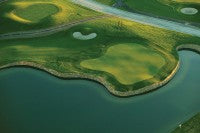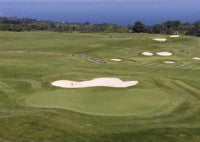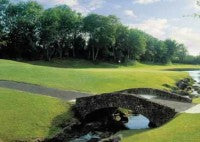Green behind the ears
 Creeping Bent Grass (Agrostis stolonifera ) (Agrostis palustris) has a relatively short and, dare I say, not so smooth history in the UK. Nonetheless, it is an important history with much to be learned from it. If my memory serves me correctly, the first Creeping Bent Grass (CBG) greens sown in the UK were at Moor Allerton Golf Club around 1971. This was the first Robert Trent Jones design in the UK and I think he specified Penncross for the greens.
Creeping Bent Grass (Agrostis stolonifera ) (Agrostis palustris) has a relatively short and, dare I say, not so smooth history in the UK. Nonetheless, it is an important history with much to be learned from it. If my memory serves me correctly, the first Creeping Bent Grass (CBG) greens sown in the UK were at Moor Allerton Golf Club around 1971. This was the first Robert Trent Jones design in the UK and I think he specified Penncross for the greens.
What I do know for certain is that my first experience of Agrostis Stolonifera was also my first experience as a greenkeeper. In 1974, as a sixteen year old apprentice, at Badgemoor Park Golf Club near Henley on Thames, I had to cut all nineteen Penncross greens. This happened on more than one occasion and involved using the club's only working 18 inch Ransomes Auto-Certes.
This was a large enough task in itself, however the Head Greenkeeper had a penchant for Nitro Chalk (applied at 2oz per square yard) and liked washing it in with copious amounts of water from the new 'pop-up' system. I was taking an average of six boxes of clippings off each green (nine being the record), leaving a distinct step between the cut and uncut surface. At least, as a beginner, I was able to see my line!
This is a perfect example of why Creeping Bent Grass as a surface for greens got off to a bad start in the UK. Architects, that had seen the quality of the surfaces that could be produced in the States and Spain using Agrostis Stolonifera, started to spec it into new courses in the UK.

These new developments were often looking for a competitive advantage, and equated CBG to quality greens. The problem with this was that the very necessary greenkeeping skills to manage this aggressive grass were not available in the UK.
My boss at Badgemore Park had worked for a spell in Spain on a course sown with Creeping Bent, and was employed for his 'expertise'! Even if a development has a greenkeeper experienced in maintaining CBG surfaces, they have to have the equipment and manpower resources in place to implement the management programmes required. This combination of knowledge and resources did not come together in the UK until the development of East Sussex National in 1988 - more on this landmark development later.
Eighties fashion
In the meantime, during the late seventies and early eighties, four or five other developments went down the CBG route. Notably, Jack Nicklaus specified it on his design at St Mellion and, I believe, Derek Ganning grew it on Thomas and Allis' design on the Brabazon at the The Belfry. These projects subsequently suffered the wrath of Jim Arthur, who was most scathing in his criticism of the use of this American invader. There is no doubt that the use of CBG was bracketed, along with Augusta National, as having no place in, or bearing, on the management of golf courses in the UK.

Many, who knew even less than those wrestling with its maintenance, made statements like, "it is not suitable for our climate in the UK", "it won't survive our winters" and, rather more stupidly, "it causes thatch". Bad greenkeeping practices, thus bad greenkeepers, cause thatch!
This said, there were no great success stories with CBG until East Sussex National or, more importantly, its Course Superintendent, Ken Seimes, arrived in the UK. I remember Jack McMillian, who was at Sunningdale at the time and as ever had his ear to the ground, phoning me to ask if I had seen what was going on there.
I had not, so Jack and I went down to meet Ken and what we saw was amazing. Ken had greens, that had only been sown down sixteen weeks, that putted better than either Sunningdale or Wentworth or, for that matter, any greens I had seen in the UK. Not only this, but all of his playing surfaces were Creeping Bent! Penn Links greens, Penn Eagle fairways, Penncross tees.
Ken was brought over by the Canadian developer to work with the American architect, Bob Cupp, and to grow-in and maintain the courses. As a graduate of Penn State University, Ken had been tutored by Dr Joe Duich who has pioneered the ongoing development of the Penn varieties of CBG. So, Ken knew what he was doing and also had the budget to do it.

The initial agronomic success of East Sussex National, coupled with the boom in golf development at the end of the eighties and early nineties, led to seven new courses with greens sown with CRB in the UK. All of these being at the top end of the market, employing Course Managers conversant with managing its operating maintenance budgets to match the needs.
In addition to the Penn varieties, we saw Providence (an Agrostis stolonifera that was developed by Seed Research of Oregon and brought to market in 1987), sown at The London Club. Meanwhile the breeders in America continued to develop their varieties and we have since seen greens sown with Penn A-4 and Penn G-6, most notably at The Grove.
How many?
When I sat down and thought about how many courses in the UK have greens seeded with Agrostis palustris, to my surprise I could only come up with twenty-five courses. This only represents 1% of the UK's golf course total. When you consider that Ireland has approximately fifteen courses with CBG, many of them recent developments, it is not really a number that makes an impact. Except that they were all top-end projects of their era, this high-end use is the reason that there have been so many projects using CBG in Ireland.
Of the UK projects, I think it would be fair to say that half were very successful in producing great surfaces within the first five to seven years of their lives. The others didn't get off to a good start, and quickly went though a number if differing management regimes that doomed them to the old foe. 
Of the successful ones, most have eventually succumbed to Poa annua invasion and, at best, are now a 50-50 mixed sward. Sadly, for those of us who have putted on pure creeping bent only greens, very few remain shining examples. That brings us up to date with Creeping Bent Grass in the UK, so what has been learned and does CBG have a future over here?
Creeping Bent Management
There is no doubt that well managed CBG provides one of the finest putting surfaces, to my mind second only to a fescue dominated sward. It may only appear on the lower half of the R&A's sustainability ladder, but it is on the top rung when it comes to fast, uniform, true, high quality putting surfaces. It is often specified at the high-end developments because of this quality.
Its speed of establishment is also a major factor in specifying this grass. It rapidly provides a dense cover that is capable of tolerating low cutting heights soon after colonisation. This shortens grow-in times, providing not only earlier playing surfaces, but the commercially crucial elements of earlier marketing material and sales revenue as well.
I estimate that CBG greens add around 20% to a course management budget over a traditional greens seed mix. While many of the practices, machinery and materials required are the same, it is the frequency and intensity of the management that escalates.
Let us presume that the expertise, budget, manpower and machinery resources are in place to maintain quality CBG greens, so what are the problems?
Core and blind me
Firstly, one of the advantages of CBG, namely its aggressive stoloniferous nature, is also one of its downsides. Whilst it is able to form a dense sward, that Poa annua finds hard to establish itself in, harder than a traditional colonial bent sward anyway, the build up of organic material as a fibre can be rapid. During the growing season, dilution of this fibre is vital if it is not to become a thatch problem. Regular grooming, combined with very light sand topdressings, is a must. In fact, if possible, light sandy dressing should be undertaken every ten days from the end of May through to mid September.
Hollow coring is also a greater requirement for the management of CBG than bent/fescue or Poa annua. Removal of between 20% and 30% of the green surface annually, combined with sand topdressing, will maintain a good soil air exchange. This will provide a free draining surface interface that is compatible with the rootzone construction. Of course, as ever, these operations require careful timing to ensure rapid re-establishment of the playing surfaces, and prevent the invasion of Poa annua seed. Total annual topdressing volumes should be up around the 200 tonne mark.
Brush and Groom well
Brushing and grooming regularly will produce a much better surface texture than verticutting on a monthly basis. The new varieties, such as A4, while having a denser habit than the early Penn varieties, do not require, or respond well to, aggressive vertical mowing operations.
Feed me but don't get me fat
As all CBG swards in the UK are grown in high sand rootzones, the nutrient requirement is naturally higher than our traditional swards grown in soil based profiles. However, the drive for lower rates of nitrogen seems to be filtering into the feeding programmes for CBG. I would be careful not to overdo the attrition approach, particularly when it comes to nitrogen feeds for CBG. I have seen 170kg per Ha per annum recommended for A4 - this could be too low. When put into practice this past year, there has been an increase in annual meadow grass colonisation. I prefer to keep CBG healthy at all times, do not allow it to thin or weaken at all, keep it aggressive and dominant over AGM, but don't make it bloated.

At this point I should mention Silver Thread Moss (Bryum argenteum) as it is another reason for keeping the sward tight. This moss has been causing a lot of problems in the older CBG greens of late. It seems to be successful on USGA rootzones with close mown creeping bent. A more open sward, caused by a combination of low mowing heights, deeper vertical mowing and a reduction in nitrogen levels, are the main contributors to the establishment of this pernicious moss. I put this moss in the same league as Poa annua when it comes to invasiveness in CBG.
Get picky
Handpick the Poa annua from your sward regularly. If you are just starting out with a clean green sward of any type, this is the most important thing you will do. This is vital with a CBG sward, as its natural density gives you a greater chance to keep AMG at bay. Secondly, never give up! As soon as you do, you have also given in, start managing for Poa annua ssp reptans. You'll find a good article on this in last month's Pitchcare!
Short back and sides
Finally, this is the joy of growing Creeping Bent Grass greens, cut them low throughout the playing season and get them smooth and fast. Outside times of heat stress, they will take daily mowing at 2.5mm no problem. Why else are clubs spending all this money growing and maintaining them?
Future Proof
So, does creeping bent grass have a future as a golf green surface in the UK? Well, given the history that I have just outlined, the honest answer would have to be no. Even with the expertise and budgets that some of the top-end developments have had, they have not managed to provide long-term Poa free swards. Economic uncertainty has caused many of these developments to reduce the intensity of management required, typically the first thing to go is the hand picking.
The more recent story over in Ireland really points the way in terms of the future for CBG on these shores. If you have a large project investment fund that is pitched at the affluent end user, then it is highly likely that your signature architect is going to specify Creeping Bent Grass. There is no problem with this, as long as you ensure you always have the funds to keep your CBG at its best, as this is your unique selling point. As with all USPs, if you don't maintain them you are simply the same as all the rest.
KMgc - Kevin Munt Golf Consultants
Telephone: 07810 473623
www.kmgcgolfconsultancy.com
All images © of the captioned golf clubs unless stated
UK developments with greens sown to Creeping Bent Grass
Moor Allerton 1972
Badgemore Park 1972
The Belfry 1979
Old Thorns 1982
St Mellion (Nicklaus) 1988
East Sussex National (2) 1989
Collingtree Park 1990
Hanbury Manor 1990
The Wisley 1991
Buckinghamshire 1992
Bowood G&GC 1992
Stockley Park 1993
The Oxfordshire 1993
The London Club (1) 1993
Chart Hills 1993
Loch Lomond 1993
Celtic Manor (2) 1995 & 2008
Bearwood Lakes 1996
The Hertfordshire 1996
Queenwood 2000
The Grove 2004
Remedy Oak 2006
Machynys Peninsular 2008
Irish developments with greens sown to Creeping Bent Grass
Carlton House
K Club - K2
Powerscourt
Castleknock
Castlemartyr
Killen Castle
Knightsbrook
Mount Juliet
The Heritage
Bray
New Dun Laoghaire
Dunmurray Springs
The Old Head of Kinsale
Beaverstown
Glen of the Downs
